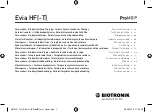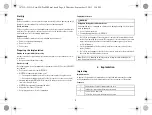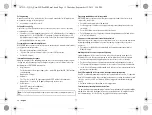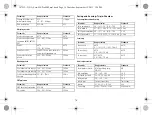
4
Device Variants and NBG Codes
Evia family
The following device variants are available:
NBG code for Evia HF(-T)
DDDRV is the NBG code for the antibradycardia mode of the triple-chamber device:
Diagnostic and Therapy Functions
General overview
All the systems have extensive features that allow quick diagnosis and delivery of safe
therapy for bradycardia conditions.
• Automatic functions make it easy and fast to implant, configure, and check the
pacemaker.
• Auto-initialization after implantation: the device automatically detects the
implanted leads, sets the polarity and activates the automatic functions after
10 min.
Diagnostic functions
• Data from the last 10 interrogations and follow-ups are recorded as well as
arrhythmia episodes; they are stored together with other data to assess patients
and the state of the device at any time.
• Automatic below-threshold impedance measurement is performed in the device
independent of the pacing pulse in order to check the lead for proper functioning.
• When performing follow-ups using the programmer, the IEGM is indicated with
markers after applying the programming head during the test procedure.
Antibradycardia pacing
• Sensing: the amplitudes of the P and R waves are measured in the implanted device
fully automatically to record varying amplitudes. The sensitivity for the atrium and
ventricle is adapted automatically on an ongoing basis. The measurement data are
averaged and the trend can be displayed.
• Thresholds: atrial as well as ventricular pacing thresholds are automatically deter-
mined in the device. Capture control is used to set the pulse amplitudes so that
pacing is performed with the optimum atrial and ventricular amplitude for the
patients with each change of the pacing threshold.
• Timing: pacing is checked particularly carefully in the atrium. The atrial refractory
period is adapted automatically in order to avoid pacemaker-induced tachycardia.
(Auto PVARP function: automatic post-ventricular atrial refractory period)
• Additional, special form of rate adaptation: an increased cardiac output require-
ment is detected using physiological impedance measurement. The measuring
principle is based on contractile changes (inotropy) of the myocardium (CLS func-
tion: Closed Loop Stimulation). The suitable rate adaptation is automatically initial-
ized and optimized in CLS mode.
• Ventricular pacing suppression: unnecessary ventricular pacing is avoided by
promoting intrinsic conduction (Vp suppression function). The device can adapt
itself to conduction changes. In the case of intrinsic conduction, the device switches
to a DDD(R)-ADI(R) mode.
Resynchronization therapy
For resynchronization of the ventricles, triple-chamber implants have functions for
multisite pacing with possible VV delays in either direction.
• Capture Control is available for the left ventricle with automated tracking of the
pacing threshold or automatic threshold monitoring (ATM) for trend analysis.
• To ensure that no additional surgery is necessary in case of a left-sided increase of
pacing threshold or undesired phrenic nerve stimulation, different pacing polarities
can be set for the left ventricular lead with a triple-chamber device.
Device type
Variant with
Home Monitoring
Variant without
Home Monitoring
Triple-chamber
Evia HF-T
Evia HF
Note:
The setting of the mode depends on individual diagnosis. The modes are listed
in the section pertaining to adjustable parameters.
D
Pacing in the atrium and ventricle
D
Sensing in the atrium and ventricle
D
Pulse inhibition and pulse triggering
R
Rate adaptation
V
Multisite pacing in both ventricles
387513--D_GA_Evia-HF-ProMRI_mul.book Page 4 Thursday, September 12, 2013 3:34 PM






































